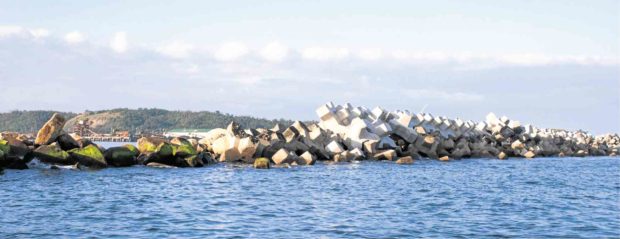
DELAYED The repair of the breakwater at Port Irene, a major project in the Cagayan Special Economic Zone and Freeport in Sta. Ana town, Cagayan province, has dragged for three years. —MELVIN GASCON
STA. ANA, Cagayan — The Cagayan Economic Zone Authority (Ceza) had ordered the contractor of the P5-billion breakwater project in Port Irene here to repair the damaged structure — a contractual obligation it had not fulfilled for almost three years.
“We have given [contractor Sta. Elena Construction Inc.] the chance to do these repairs, and I told them we will monitor their day-to-day activities, and see if they are really making progress. If not, then we will start filing charges,” said lawyer Raul Lambino, Ceza administrator.
4 contracts
The kilometer-long breakwater was damaged by Typhoon “Ineng” (international name: Goni) in 2015, even before it was completed.
“I told the owners of Sta. Elena they have to make up for the delay by speeding up work, adding more equipment and manpower. We have been given a commitment they would,” he said, referring to Sta. Elena president, Alice Eduardo.
The company has four contracts worth P5.1 billion for the construction of the 1-kilometer breakwater, according to documents.
Overpricing
The breakwater has become the subject of scrutiny for supposed overpricing, amid allegations that the project was used to funnel Priority Development Assistance Fund (Pdaf), which had been declared illegal by the Supreme Court.
According to documents, Sta. Elena was contracted for the project’s last phase to build the remaining 750 meters of the breakwater by an average cost of P5.7 million per meter or almost twice the cost of previous phases.
But even the delayed repair work on the breakwater, or a subsisting concession agreement, could not hamper Ceza’s plans to expand and modernize Port Irene, the main port of the Cagayan Special Economic Zone and Freeport, Lambino said.
Port rehab
“We cannot sit idly here and just wait for things to happen; we believe that 15 years has been too long for Apit to have done something,” he said, referring to the Asia Pacific International Terminals Inc. with which Ceza has entered into a 25-year concession agreement.
He said Ceza has started accepting concessions from foreign companies for the rehabilitation of Port Irene, starting with the forging last week of an agreement with a South Korean firm, Fairbridge Overseas Development Philippines Inc.
“But the government at the moment does not have the money for the dredging of the port, and if we have to ask for funds, we have to go through all the bureaucratic processes. This is why we are allowing private partners to come in,” he said.
Dredging
Under its port modernization program, Fairbridge seeks to dredge the mouth of Port Irene’s navigational channel, upgrade the existing piers and wharves, and reinforce the breakwater and repairing its storm-damaged portions—at no cost to the government.
In return, Fairbridge would be allowed to extract the sea sand dredged from the harbor and its environs and use the harbor for its business, Lambino said. —MELVIN GASCON